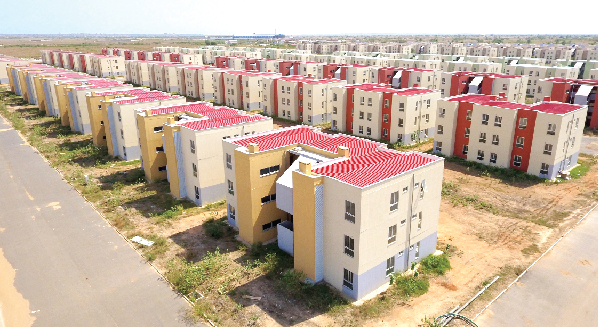Abandoned projects: Ghana’s monument to neglect (Part 2)

Last week, I wrote about how successive governments abandon on-going projects, either initiated by a previous administration, or by the party in power itself.
The projects span various spheres of national development such as health and educational facilities, housing schemes, sports infrastructure, roads and highways, among other things.
For starters, I cited the abandonment of the $200 – million Saglemi Affordable Housing Scheme at Prampram, as a classic example of a monument to neglect.
By that I mean Ghana’s notorious tendency to waste our scarce resources by pumping vast sums of money into projects already investigated and certified feasible, only to discontinue them, sometimes even when almost completed.
The 300-acre Saglemi project initiated by the previous NDC regime comprises a 5000-unit residential facility to accommodate middle and low-income earners within Accra and its environs and reduce the housing deficit in the metropolis.
When the NPP took over from the NDC in 2016, the first phase of the project, consisting of 180 blocks of flats with 1,500 residential units, had already been completed at the cost of $200 million. But to date, no allocations of the completed flats has been made.
The ruling government’s explanation is that it has detected evidence of financial impropriety in procurement as well as inconsistencies in contract documents handed over to it by the previous administration.
Meanwhile, the workers for whom the project was undertaken, continue to wallow in squalid living conditions while the buildings deteriorate at a fast rate.
Whatever the problem, and for the sake of the beneficiaries, is there no way allocations can be made while investigations into allegations of financial malfeasance are conducted?
This week I continue with another project which can be rightly categorised as a monument to neglect. I am referring to the Kwame Nkrumah University of Science and Technology (KNUST) Teaching Hospital.
The project was initiated in 2007 by the university’s College of Architecture and Planning with support from the Ghana Education Trust Fund (GETFund) under the auspices of former president J.A. Kufuor.
The university banked on its internally-generated funds and donor support to raise enough money to supplement government’s contribution.
However, the project did not begin until 2008. Amid much fanfare, the Asantehene, Otumfuo Osei Tutu who is the Chancellor of KNUST, cut the sod for the $125-millionwork to begin in earnest.
The 800-bed capacity hospital, was expected to be one of the leading medical training and healthcare facilities in the country, to enable patients to access the facility towards easing the unnecessary pressure on other health facilities in the Ashanti Regional capital of Kumasi.
Apart from providing health care services, the project was also expected to serve as a teaching, research, and training facility for health and allied professionals critically needed for efficient health service delivery in the country and beyond.
Covering a land area of some 71 acres, the project, which is sited at Boadi in the Oforikrom Municipality, has among its features, a cardiothoracic and neurosurgical centre, a diagnostic unit and laboratory, morgue, administration and Out-Patient-Department (OPD) blocks, wards, security post, effluent chambers as well as a laundry unit.
It was expected to be completed in six years which should have been 2014, with the first phase comprising the administration block and facilities required to kick-start operations projected to be ready for use within two years.
But after the superstructure was only partially completed, this very important project was abandoned due to inadequate inflows from the KNUST’s internally generated funds and external donors. For that reason, the project has remained stalled for over a decade. What?
Do we not have any sense of urgency? Where do our national priorities lie? How can we sacrifice so beneficial a programme as improved health care for the people with the unjustifiable excuse that we do not have money?
But we have money for other useless ventures that serve the parochial interests of advocates of such projects. Even if other constituencies have overwhelming comparative advantage for the siting of certain projects, some unscrupulous players in government, would scheme and pull all kinds of tricks to have them situated in areas that would ensure personal dividends. For them the end justifies the means.
It took repeated reminders from the Asantehene to get the project resumed, as it were, only recently. About four years ago, that is, in 2018, at the 52nd graduation ceremony of the university, attended by the then Minister of Education, Matthew Opoku Prempeh, the monarch urged the government to release funds to ensure the completion of the project
Then, two years later in 2020, during the investiture of Professor Rita Akosua Dickson as the new Vice-Chancellor of KNUST, Otumfuo repeated his concerns about the neglect of the project in the presence of President Nana Addo Dankwa Akufo-Addo.
The Akans have a time-tested proverb that, if you want to communicate with God, just speak into the air. That is the wisdom Otumfuo applied, and it worked.
In an urgent and emotional direct appeal to the President, Otumfuo Osei Tutu said: “I have written a series of letters to the Ministry of Finance and to the office of His Excellency the President, but it appears no action has since been taken.”
“The KNUST,” he said, “has been very instrumental in the development of the country’s health systems and the completion of this facility will go a long way to contribute to the sustenance of such support…The time to act is now!” the Asantehene stressed.
In response, President Akufo-Addo assured that the project would be completed soon, saying that the tenure of the new Vice-Chancellor would be marked by the construction of the teaching hospital which is so dear to the heart of the Asantehene and the university community.
Another Ghanaian proverb in Akan says: “Treeeeeempoantremu a, wosekoko?” This loosely translates to: “Even when you poured it (maybe milk or any other drink) liberally, it was not sufficient for me, how much less would mere squeezes of drops suffice?
My point is, for over a decade the first phase which was supposed to be completed in six years did not reach anywhere.
Now the president says very soon the first phase will be completed. My Nigerian friends would say, “OK ooo, we shall see.”Not that I do not believe it. It is just too good to be true. Besides, my fear stems from that favourite word of politicians- soon. That is the snag. Why not put a timeline on it for us to be sure?
Probably, it will work this time. In fact, in 2021, the Government, according to the Asantehene, in response to his numerous appeals, initiated moves by releasing funds for the continuation of the project.
Media reports have quoted the Asantehene as saying that information available to him indicated that the first phase of the KNUST Teaching Hospital project would be completed by October 2022.
Otumfuo Osei Tutu revealed that government had already resumed construction works on the project, adding that the government had also made the necessary provisions for the second phase of the project in this year’s budget.
Contact: teepeejubilee@yahoo.co.uk
By Tony Prempeh













